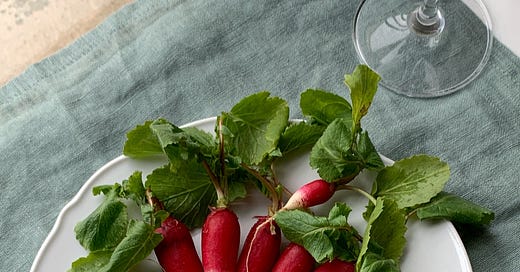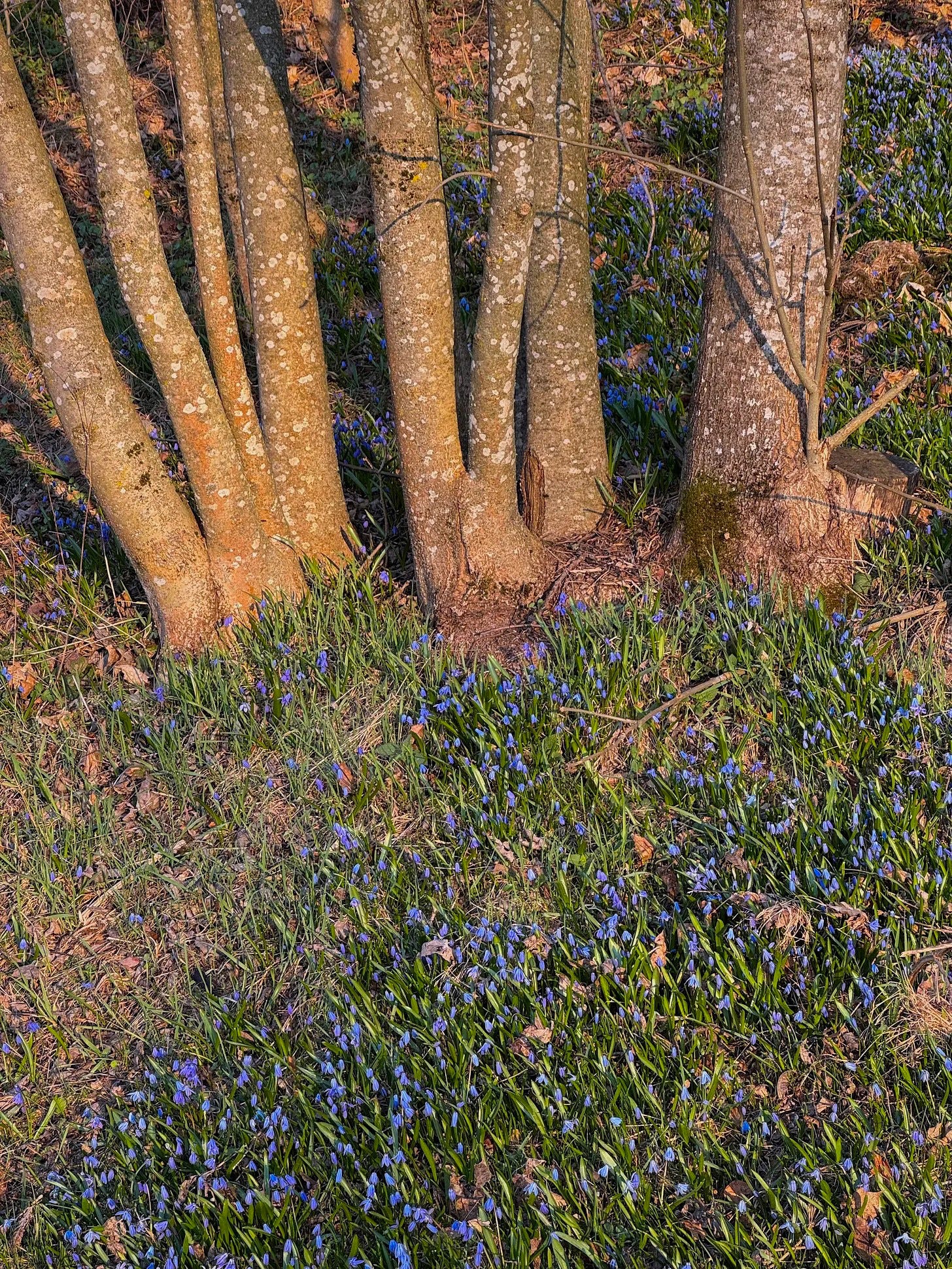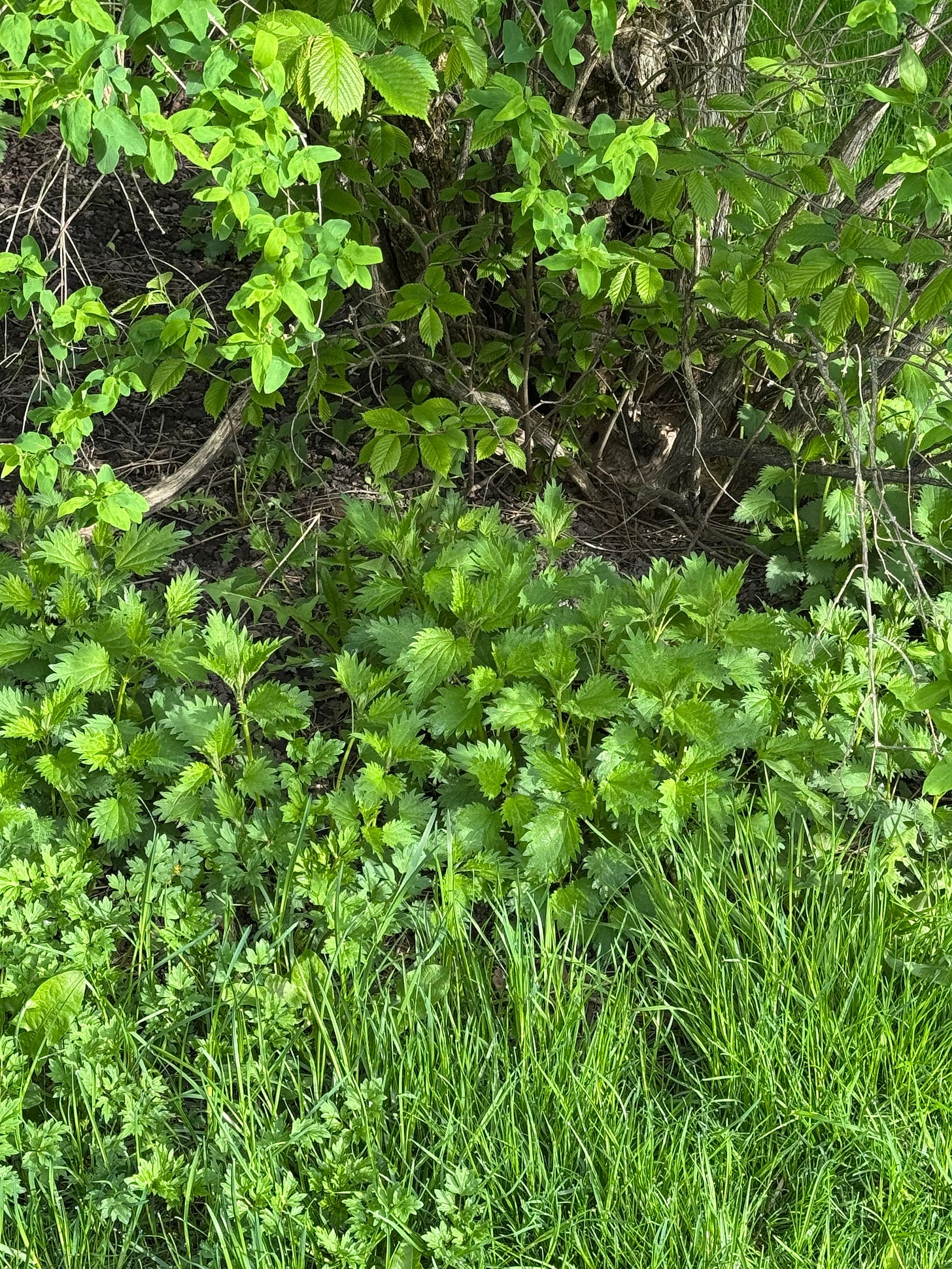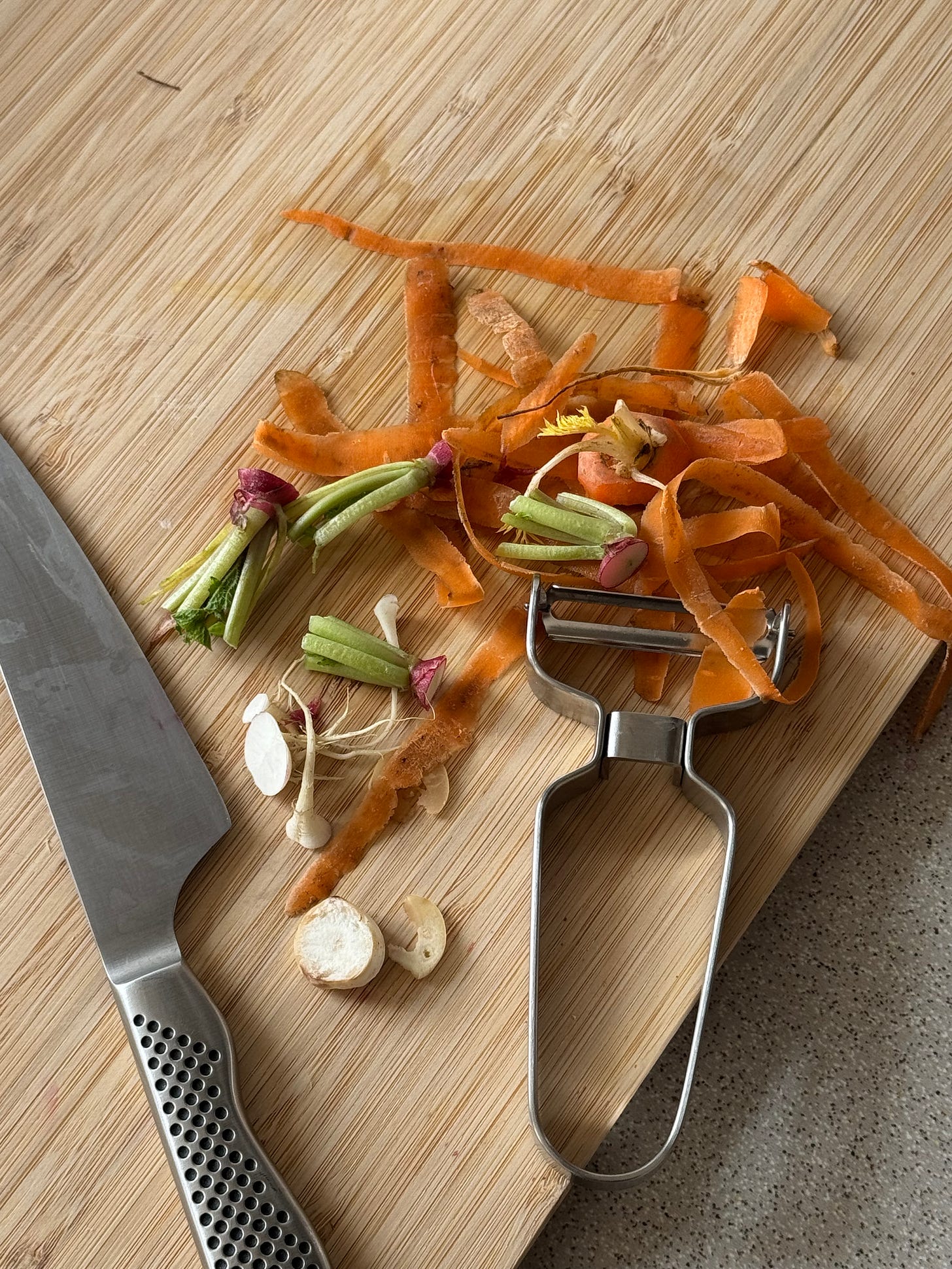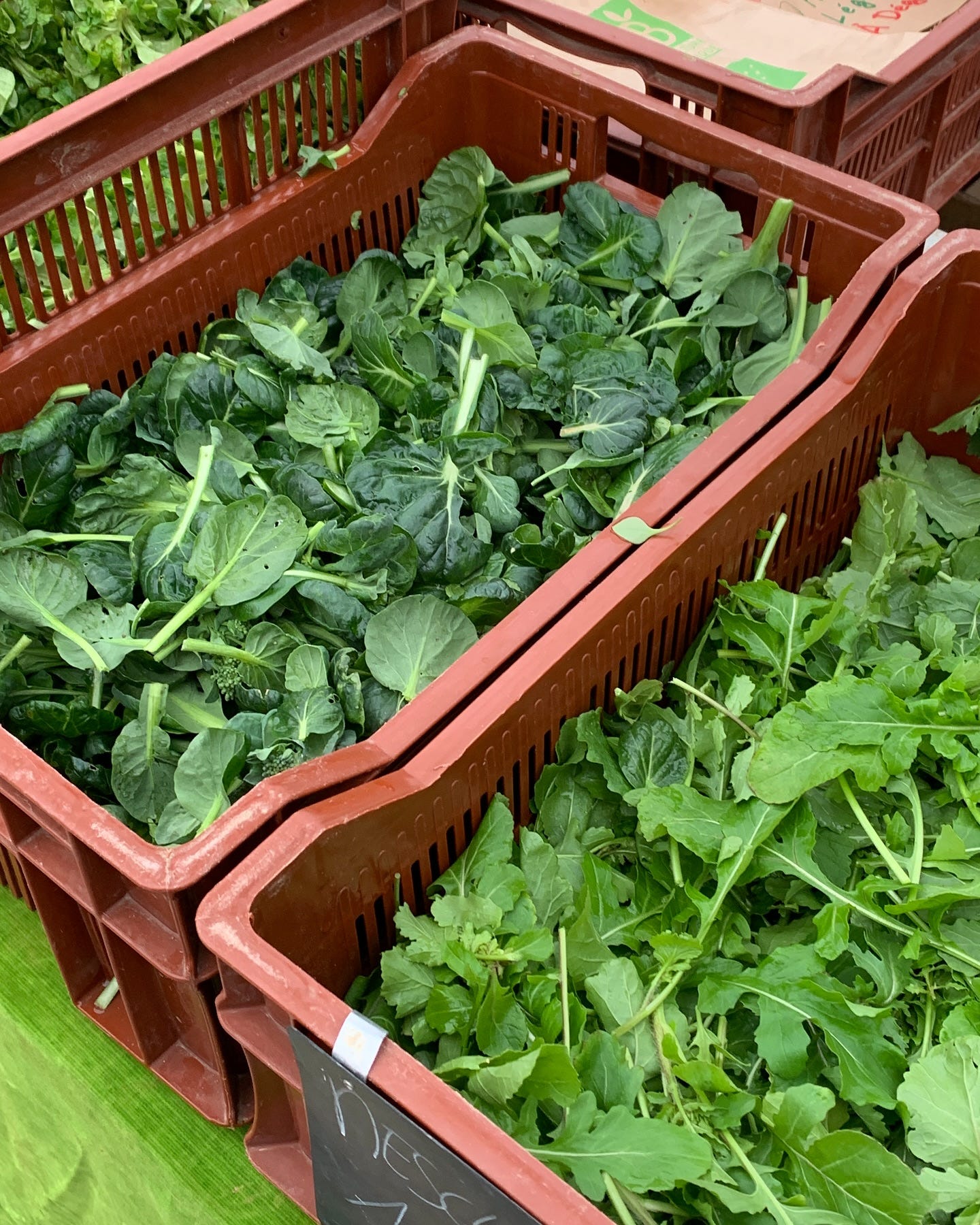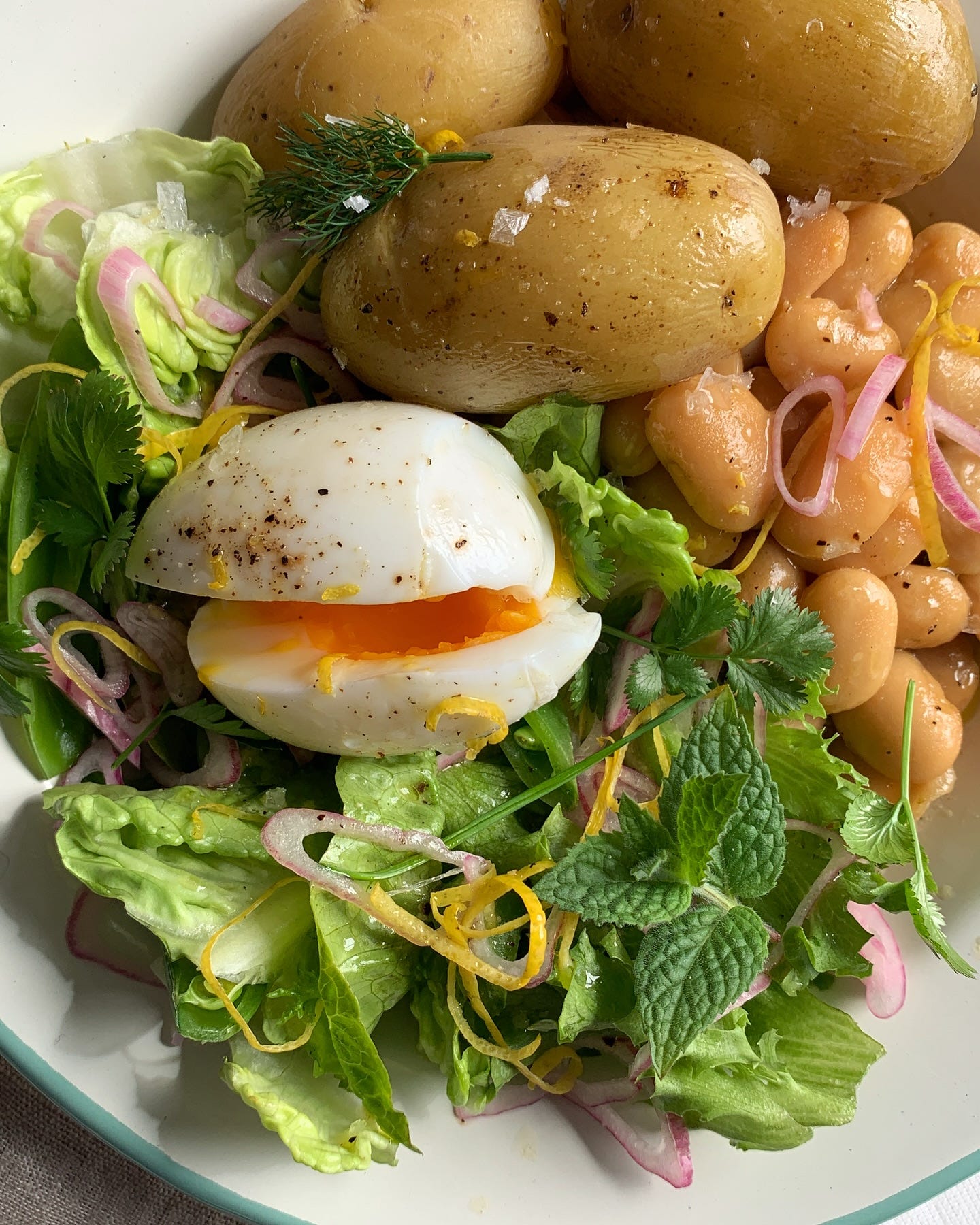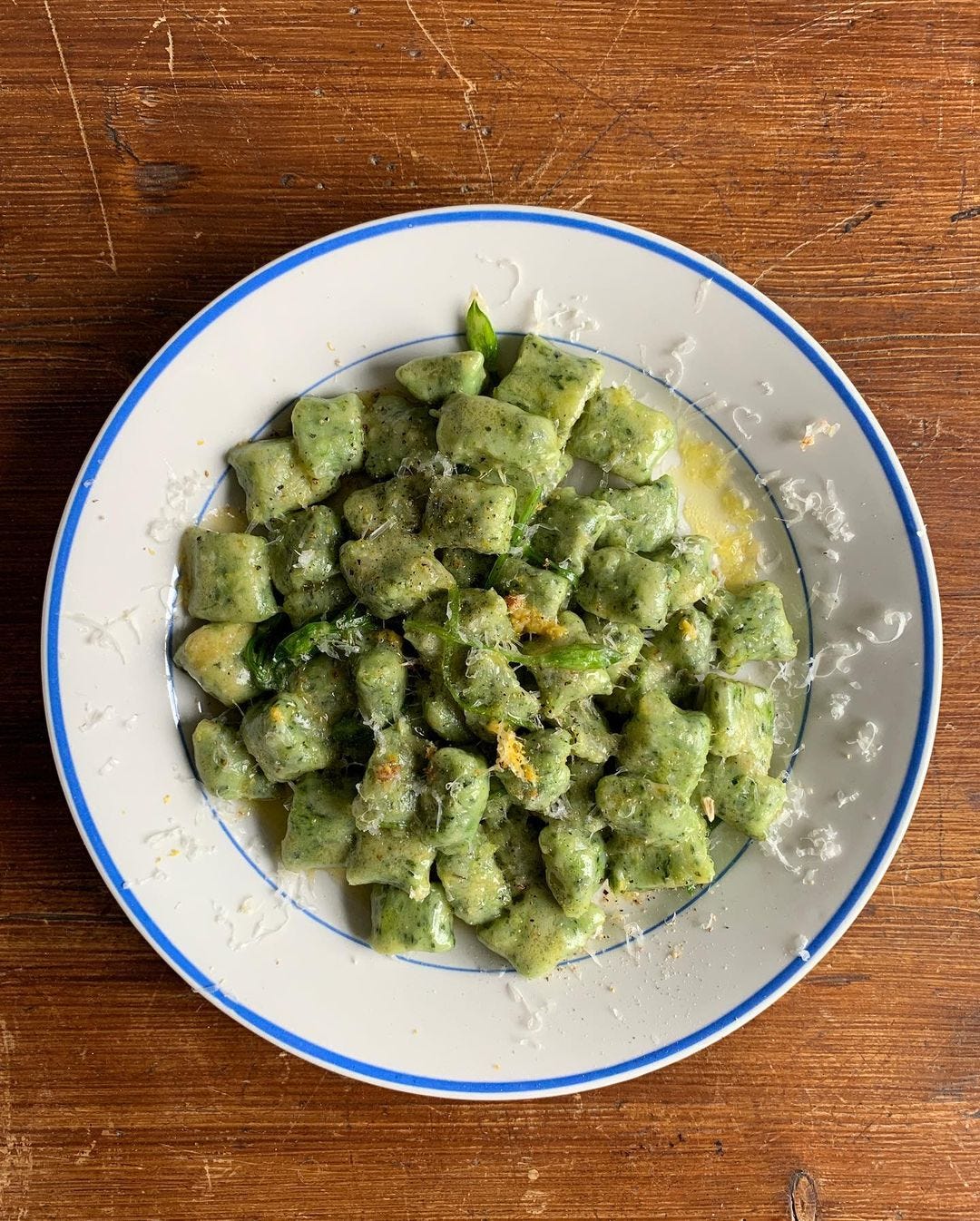Allô! 👋
Welcome (back) to good food at home, the monthly-ish newsletter featuring simple, seasonal, and sustainable meals, tips, and ideas. For more recipes, cooking Q&As + access to the full archive, consider joining the community of readers who support the newsletter by also subscribing to seasonal sundays, the supplement that focuses on fresh produce at its peak!
It’s amazing how quickly and intensely things change between the first and last days of April.
At the start of the month, the season was still finding its feet — temperatures regularly dropped below freezing at night, lawns looked more like sorry mud fields than lush havens, and any sparse blossoms that dared to bloom seemed small, frail, and unsure that they’d chosen the right time to shine. Now, on the cusp of May, grasses are surging forth, abundant and confidently green, flowers practically spill out, as vividly varied in fragrance as they are bold in hue, and the late afternoons have grown so warm that jackets increasingly find themselves relegated from clear necessity to mere accessory.
Blink and you may miss it: this year’s spring is in full swing.
Cherry petals scattered like confetti in the streets, the scent of the season’s first barbecues and grills, the tender sight of tiny fuzzy ducklings, the feel of a rain that is, for the first time in a long time, not quite so bone-chilling.
This month brought with it many such joys, humbly waiting to be noticed.
April showers may bring May flowers, but they also foster tender young wild things. And oh, what joy foraging for such small things brings!
Young dandelions, stinging nettles, Turkish rocket, spruce tips, sea kale, wild garlic, mayflower, ground elder, wood sorrel, magnolia blossoms, pine shoots, sweet cicely, fiddleheads, rowan buds, cherry blossoms — the list of delicate, immature shoots, stems, and blooms currently erupting at every turn is as frantic as it is fleeting.
Finding and savouring these small treasures becomes a true exercise in seizing the season, as the window for gathering and enjoying such spring delights is very narrow indeed (yet another thing that makes this time of year so special!). Turn your back for one moment and what was briefly edible and tender is already past its prime, now too bitter, too fibrous, or simply too mature to safely ingest.
The fleeting nature of these forage-able finds is a comfort in a way, as it represents a bridge of sorts, out from the old and into the new: just as these wild greens grow, there are still a few farmed vegetables left over from last season (even though most that were stored or overwintered have either run out at this point, or are sprouting and trying to go to seed) all while new-season crops are just starting to deliver.
No fruit yet, of course (April is decidedly a month defined by a lack of fresh fruit. Instead, it is a time best suited for jams, jellies, and other preserves, be they pickles, ferments, candies, syrups or fruits frozen whole and raw or mashed and stewed). But the year’s first radishes and spinaches are here to delect and delight. Green garlic, lovage, and lemon balm are already available at my nearest farm shop, along with abundant eggs and artisan breads — reassuring signs of the imminent abundance ahead.
And then there are the pea shoots: tender, sweet, and hopeful. A promise that fresh peas themselves are not all that far behind, and a gentle reminder that good things are often worth the wait.
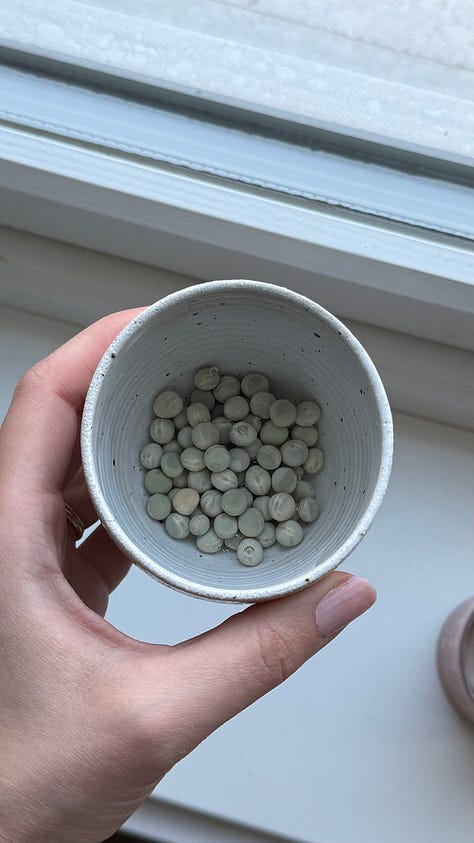
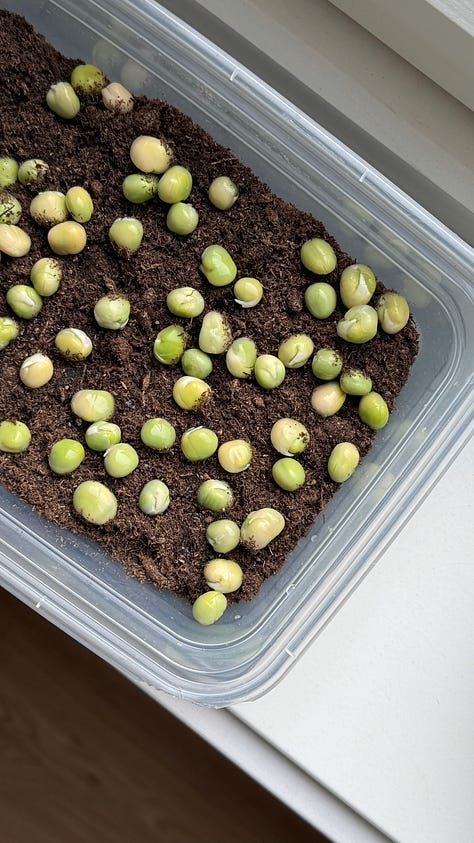
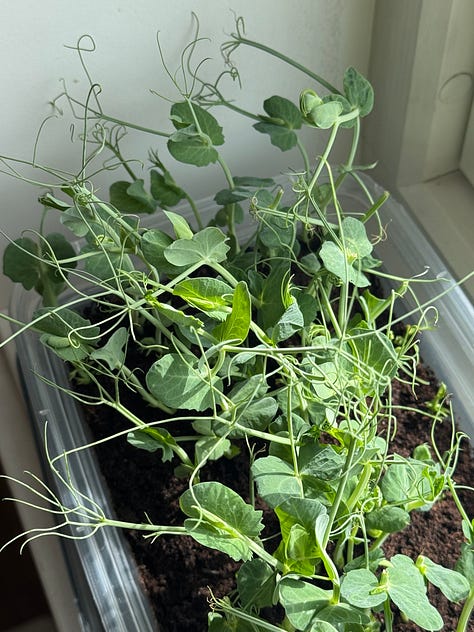
ㅤ
Another thing that has me looking forward to the coming weeks is the changing daylight. As mentioned in previous issues, the one thing I notice most as the seasons progress here in Norway is the change in the light. At this Northern latitude, it is near-impossible not to.
Whereas the winter sun was low and long, allowing one to bask in its brief-but-warming rays from the deep comfort of one’s indoor retreat, the spring sun is beginning to stretch so high in the sky that its short shadow now only makes it way partly through a room, drawing you nearer and nearer the window until the only solution becomes to step outside and bask in its glory fully.
A higher sun also means longer days, more opportunities for al fresco meals, and, of course, more growth in the garden. A win-win for anyone who takes great pleasure in enjoying freshly harvested food all throughout the growing season.
One last thing before we jump into the newsletter proper: I’m not a big fan of tooting my own horn, but my friends and family insist, so I should tell you, in case you missed it, that I was very kindly interviewed by ConsiderBeyond this month. You can click below to read the piece in carousel form on Instagram, or follow the link above to access the article on their website.
It was a very nice opportunity for me to speak more about why I do what I do and what good food means to me. I hope that those of you who chose to read it find it a nice opportunity to get to know me a little better too.
In this April issue of good food at home, in addition to a quick overview of which foods are currently in season, you'll find recipe inspiration from the newsletter and website, as well as a seasonal no-recipe recipe for putting a delicious end to this year’s hungry gap, and — as always — a few parting links as food for thought.
ㅤ
Wishing you all a wonderful May ahead,
👋simone
P.S. Like the newsletter? Leave it a ❤️ to help it grow!
mid-spring is coming:
what to shop, harvest & forage for
🌱
Having spent a few springs in different parts of the world, I know first-hand that your spring is unlikely to look like mine, and vice versa — even if we happen to be living in the same country. Growing zones, plant hardiness areas, and frost dates vary widely from area to area and region to region, let alone nation to nation. These depend on local microclimates as well as soil types and day lengths (influenced by latitude, but also altitude: mountains tend to get colder the higher you go, and valleys may get more shade but less wind than wide open plains, etc. etc.… growing food is hard! Just ask a local food grower.)
All this to say: try not to get too disappointed if you see other people online posting about “spring” meals that look nothing like yours. One day your rhubarb and asparagus will come (I haven’t eaten either yet myself this year).
My best tip is to support local growers and grocers, and to buy what is at its best where and when you are. More often than not, shopping this way leads to better taste, less waste, and healthier practices and outcomes at every level of the food system.
To be considered in addition to your usual non-perishable staples, here are some suggestions for fresh new things you may be able to look forward to in the coming month (if you haven't been enjoying them already)!
Below, some things to look and enjoy for in mid-spring, when greens reign supreme, pinks trickle in, and whites whisper kindly:
Lots of green things
Artichokes (peak)
Arugula (peak)
Asparagus (peak)
Cardoons (late)
Chives (early)
Cime di rapa / Rapini / Broccoli Rabe (late)
Coriander (early)
Cress (peak)
Fava beans / Broad beans (early)
Fiddleheads (early)
Green garlic (peak)
Green onions (early)
Lemon balm (early)
Miner’s lettuce (peak)
Monk's beard (late)
Nettles (peak)
Peas (early)
Pea shoots (peak)
Ramps or Wild garlic (peak)
Sage (early)
Spinach (peak)
Sprouts of all kinds (peak)
Watercress (early)
Some pink (and purple) things
Purple artichokes (peak)
Overwintered beets (late)
Pink-stemmed chard (late)
Radishes (peak)
Red spring onions (peak)
Rhubarb (early)
Sorrel (peak)
Strawberries (early)
Turnips (late)
A few white(ish) things
White asparagus (peak)
White-stemmed chard (late)
Morels (peak)
Green/young garlic bulbs (early)
Stored potatoes (late)
White strawberries (early)
By the way, if you're unsure as to what is in season near you, don't hesitate to ask! At your local market (if it has opened for the season), at your local greengrocer's, food co-op, farm shop, CSA pick-up spot, or community garden. You might even be able to ask that nice neighbour of yours with the green thumb and well-established vegetable garden what’s good at the moment (lucky you).
And, in case you don't have access to these resources, do know that all hope is not lost: you can be the first step in making a change. Talk to others around you, they may be longing for better access to local food too! In the meantime, the internet is your friend: use it to search for what's in season in your area and to look for nearby food growers you can follow on social media. Good seasonal ingredients might very well be right around your corner — you just won't know until you look.
mid-spring meals 🌱
Whether you’re deep in asparagus dishes already or simply happy to see the season’s first green onions at the market, the middle of spring is a great time to savour and appreciate all things green, with a few occasional splashes of pale yellows, delicate whites, and pastel pinks sprinkled in between.
My go-to’s at this time of year usually involve fresh tender herbs, eggs, young alliums, radishes, or some combination of the above. Think: omelettes, herb butters, custards, flaky tarts, green soups, fresh risottos, Weekday Bowls (see below), and simple pastas.
Scroll down for recipes and tips I hope inspire you to savour the journey through this very short but precious time of year.
(Recipes marked with a 👋+ are for paid subscribers only, though each paid post contains content available for all to read!).
a spring soba salad
Fantastic for warmer spring days, and a lovely excuse to abundantly consume the season’s first fresh tender herbs (lemon balm is my favourite).
ㅤ
a Weekday Bowl template
Ideas for simple, satisfying lunches or dinners that keep things fresh without stress or mess.
ㅤ
flaky green onion flatbreads
I love scallion pancakes, am a well-known paratha fanatic, and grew up unreasonably excited at the prospect of devouring some freshly-made Jamaican roti. Below is my method for how I like to combine all three.
ㅤ
wild garlic gnocchi
Not my recipe (credit goes to
!), but it’s a spring dish too good not to share here. I make it every May with the season’s first ramsons, using both leaves and flower buds for maximum fresh garlic flavour....and more:
green onion aglio e olio 👋+
a speedy mint & (frozen) pea soup
spring soups, salads, and sandwiches 👋+
savoury cheddar sage scones
five ways with radishes 👋+
recipe for a delicious hungry gap soup ✍️
This month, I’m sharing a very beige, very hearty, root vegetable soup.
Sure, the first (fresh! exciting!) crops of the year are increasingly ready for harvest, but that doesn’t mean we should shun what’s still leftover from last year’s growing efforts.
Enter: the stored vegetable. Getting wrinkly, sad, sprouty? Maybe! But so long as it’s not soft, fuzzy, a dubious colour, slimy, or smelly, I say it’s still good to eat.
So that’s how this accidentally glorious end-of-hungry-gap dinner came about:
I had in my kitchen a sad onion, some somewhat shrivelled cloves of garlic, two slightly sprouting potatoes, two very oxidised parsnips, and a rather dehydrated half-a-rutabaga that all needed using up. The evening weather was wet and grey, so naturally, I decided to make soup to honour these valiant ingredients who’d managed to survive well past winter’s end.
Cooked with butter, cream, salt, bay leaves, apple cider vinegar, and nothing more, it turned out to be delicious. So delicious, in fact, that I immediately wrote down exactly what I’d done so that I could share it you (and also come back and make it myself again and again).
Here’s how to make the potato, parsnip & rutabaga soup above:
ingredients
1 yellow onion
2 medium potatoes (waxy)
2 medium-small parsnips
½ large or 1 small rutabaga
2 medium bay leaves
2 medium cloves garlic
heavy cream (35–39% fat)
apple cider vinegar (with the mother)
butter
extra virgin olive oil
sea salt
black pepper
ㅤ
method
Melt a small pat of butter in a large heavy-bottomed pot over medium heat.
Peel, halve, then slice a yellow onion. Add it to the pot, season with a tiny pinch of salt, and stir.
Remove any nubby sprouts, peel, then roughly cube two medium potatoes. Add them to pot, season with a tiny pinch of salt, and stir. If at any point the vegetables need a bit more butter, add a bit more butter.
Peel and trim two medium-small parsnips. Slice them into coins. Add them to the pot, season again with a tiny pinch of salt (we are building up layers of seasoning!), then stir.
Put on a big kettle of water to boil. Peel and trim half of a large rutabaga (or a small one). Slice it into thin sheets. Add it to pot, season it with a tiny pinch of salt, then stir.
Once everything is looking nicely caramelised and the bottom of your pot has gone a lovely nutty brown colour, deglaze the pot with enough of the boiled water to cover the veg. Add in two medium dried bay leaves (could use 1 large or 3 small leaves instead), two medium cloves of peeled garlic, and a good pinch of salt.
Bring everything to a gentle boil, then reduce the temperature and leave the soup to simmer over medium heat until you feel enough time has passed for the flavours to properly infuse into the water without overcooking the veg (for me, that was about 15-20 minutes).
Remove the bay leaves, add in a good glug of heavy cream, and whizz the soup smooth using an immersion blender.
Taste and adjust the seasoning with salt, tiny dashes of apple cider vinegar, and more cream to taste.
To serve, ladle the soup into bowls, top with a fine trickle of extra virgin olive oil, a gently crunch of flaky sea salt, and a crack or two of freshly milled black pepper. Enjoy straight away while still hot.
Probably also lovely with more elaborate toppings or cooked in a homemade broth instead of water, but you’d be surprised just how much depth of flavour you can coax out of these veg just by browning them in butter before leaving them to simmer together!
last, but not least:
the public health corner 🔗
In case you didn’t know, public health is my jam (more on that here, here, and here) — it informs everything I do! And, as always, I like to leave you with a few parting links relating to the topic, as food for thought:
🗒️ ONE ARTICLE
Bans on junk food advertising in outdoor spaces derailed by industry lobbying, The British Medical Journal (BMJ Investigation)
📺 ONE VIDEO
🎧 ONE PODCAST EPISODE
Denmark’s Food Revolution? | The Food Programme (BBC)
📘 ONE BOOK
Titans of Industrial Agriculture: How a Few Giant Corporations Came to Dominate the Farm Sector and Why It Matters, by Jennifer Clapp
📣 ONE GOOD NEWS STORY :)
On April 9th, the California Assembly Education Committee voted to advance a bill to phase out “particularly harmful” ultra-processed foods from school meals
p.s. I always have a hard time just picking one of each so, in case you're interested, there's plenty more where that came from!
If you enjoyed this post, please do kindly give it a ❤️ — it really helps make it more visible so that others like you can find and enjoy it too!
That's all from me this month — see you in the next newsletter!


